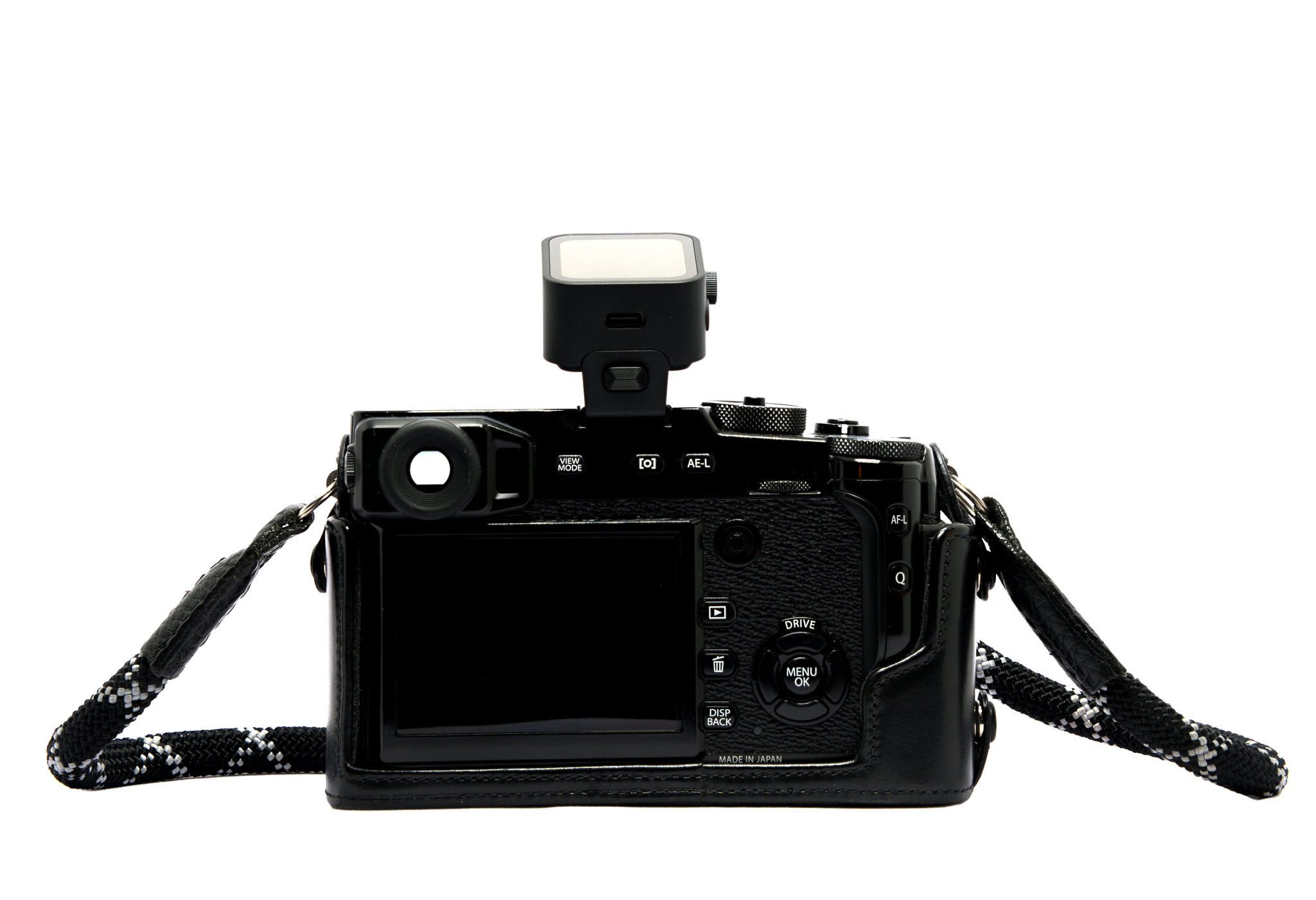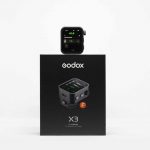In this first impression review, we’ll look at the new Godox X3/Xnano flash trigger, currently available for Canon, Nikon, Sony, Fujifilm, and Olympus. Leica is on their roadmap but not available for sale yet. In China, the unit is called the X3, so I’ll use that naming throughout this review, however in some countries, it’s called the Xnano.

I purchased two units, one version for Sony cameras and one for Fujifilm. Both were purchased at full retail price (CNY498) from Godox’s official store on JD.com in China. This first impression review is based on Godox X3 firmware 1.07 and was tested on the Fujifilm GFX100 II, X-Pro2, X-T5 and Sony A7r5.
Godox X3 Flash Trigger
I’ve been a fan of Godox’s flash system for several years. It allowed me to get into the world of controlled light without having to spend a fortune on admittedly excellent hardware from companies such as Profoto. With each successive generation of product, Godox seems to make tangible improvements to build quality, capability, and usability.
The X3 lives up to this expectation and even exceeds it. Godox has made an amazing little product that makes using controlled light so much more portable and easier to setup. I’ve been using Godox’s XPro and X2T triggers for several years and found them to be reliable but a bit bulky and utilitarian.

The new X3 changes all of that. Godox has been making incremental improvements in their devices with each generation, but this time, the X3 feels like a huge step forward. They’ve made massive improvements in usability with the highly responsive touch screen, much smaller size, and excellent battery life with USBC recharging.
When writing reviews, I hate to use the word “game changer”, but this really does feel like it. I don’t think there’s anything on the market like it. The size difference alone makes using controlled light so much more accessible. I can see myself bringing this trigger with the Godox TT350 flash on my travel adventures, where size and weight are important.
What’s in the Box
I don’t normally include this as it’s obvious what you get with most technology products. However, Godox has elevated its game again and I felt compelled to include this for that reason. Godox has included three things that most modern technology companies don’t:
- Beautiful and well designed and built case for the X3
- USBC charging cable
- Printed instruction manual
As a consumer who buys a lot of stuff, I don’t mind if the companies exclude the USBC cable and printed instruction manual, but if you’re not a collector of tech, it’s nice to have everything you need to use the device from the get-go.

I want to highlight the case design; it’s very well done. It’s super compact and uses up only enough weight to do its job well. The zipper is smooth, and the materials are all top-notch. I really appreciate this case because when doing this review, I noticed my previous triggers had scratched screens from all the travel abuse. This case should prevent that from happening.
Size & Weight
For me, this is the biggest benefit of the new trigger. It’s so much smaller and lighter than either of its predecessors. To give some context, the entire trigger weighs just 48g, which just so happens to be the same weight as the two AA batteries required in the predecessor XPro and X2T triggers!
Regarding its size, a picture is worth a thousand words, so I’ll leave it at this:

Capability
The X3 supports TTL flash for the brands mentioned in the introduction; the Leica trigger is currently under development and on their roadmap. High Speed Synch (HSS) works very well on both my Fujifilm and Sony cameras. I tested it up to 1/8000s without any issues.
The X3 can control any flash from the Godox family that has their wireless X technology. For example, I was able to use the X3 for Fujifilm to control a TT350 for Sony with the flash in slave mode and connected via the 2.4GHz wireless X system.

Battery life was a non-issue in practical usage which is a big upgrade over its AA battery powered predecessors. Godox states battery life as 10,000 flashes (with a flash every three seconds) or seven days of standby time. With USBC charging, it takes only two hours to get a full charge so it’s easy to keep the trigger topped up.
A cool feature which I enjoy using on Godox triggers is the TCM function, or TTL Transfer to Manual function. This makes it super easy to get a baseline starting point for controlling your light. Using the built-in TTL (automated settings) function, the camera and flash will determine the optimal exposure with the current Aperture, ISO settings and Shutter settings. With TCM activated, the trigger will then transfer those settings as the baseline and switch to Manual mode. You can then manually adjust from there.
Usability
Previous triggers from Godox and other brands were clumsy and hard to use with buttons serving two or three purposes. The combination of having to long-press or short-press buttons was annoying and difficult to memorize across different flash triggers and falsh units. Godox has solved all that the excellent touch screen interface.
It only took a few minutes to get everything setup and working with my existing Godox flashes. I tested it with the V1, TT350, V860 and AD200. I already had my wireless channels and ID setup across my Godox products so it was just a matter of changing one setting on the X3 and I was good to go. If you haven’t setup your wireless channel and ID, you can use the convenient Wireless Synch function on the X3 and the flash to have the two units decide what channel and ID to use.

The touch screen is very responsive, bright, high resolution and easy to use. Godox has done a superb job with the user interface. What used to take several button presses can all be done so easily now. The screen allows you to see three groups at a time, with the others just a finger scroll away. The settings are easy to see and change using the touch interface.
Build Quality
Godox continues to make strides with each iteration on their build quality. The first few Godox products I bought were what I would call, utilitarian. They did their job, but they felt like they wouldn’t last forever. Fast forward to 2024 and this X3 feels extremely well built and that it can last a long, long time.
The little dial has an Apple Watch feel to it with nice detents as you spin it and good tactile feedback. It also acts as a button just like in the Apple Watch. There are no screws, gaps, or other joinery visible. Indeed, the X3 feels like it’s built as a single unit, of excellent plastics. The screen to body transition is seamless and the hot shoe connector is moulded into the body so it’s very robust.

The only issue I found was with the hot shoe connector on the X3 Sony. I found it a bit tough to get in and out. This could be due to my A7R5 hot shoe being tight, or the X3 hot shoe connector being a bit too big. On the X3 Fujifilm, the trigger slides off and on smoothly with the release button pressed.
Performance
It works just like Godox’s other flash triggers, but just with a much smaller size and a much easier to use touch screen. All functions worked as expected, with the wireless range being excellent. In the past, I’ve had some issues with Godox triggers not working well with the trigger and flash in very close proximity, which necessitated a change in settings to inform the trigger of the targeted wireless range.
With the X3, this setting still exists, but I didn’t find I had to use it. I tested the flash in all the modes (TTL, Manual, Multi-shot, modeling light) and placed multiple flashes around my large living room. All the flashes triggered perfectly and reliably. Throughout my day of shooting, the battery life was excellent and barely went down.
Value
I’ve found all Godox’s flash triggers to be excellent value for the money. This trigger takes that value to another level. When you take into consideration the miniaturization, touch screen, excellent build quality, and USBC rechargeable lithium battery, it’s incredible that they can offer this for CNY498 (US$69). Flash triggers are something that you should only have to buy once, so spending that small amount of money provides a lot of return on the investment.

Perhaps another way to look at the value question is to look at what the system offers overall. You may want to consider the various flashes available from Godox and if they will meet your needs. I’ve heard professionals say that Profoto has better support for technical issues and warranty so that’s something to consider. Personally, I’ve never had a Godox product fail.
Since I’m not a professional photographer that would lose income if my flash trigger fails, I find the Godox products to provide exceptional value for the money. Taking these devices on travel certainly puts stress on them, but I’ll readily admit my travel exploits don’t put the same amount of stress on a product’s reliability and durability in the way that a professional would.
Conclusion
I think the X3 is going to make controlled light a lot more accessible to photographers. There’s zero familiarization required to operate this trigger. If you can use a modern phone, you can operate this trigger from the moment it comes out of the box. A flash photographer can then spend their time on controlling and shaping light instead of figuring out how to get everything up and running.
I love this little device; it makes me happy to see us make technological progress as a society when we get devices that make such big leaps forward. Godox has a winner on its hands and I highly recommend picking one up if you’re interested in controlling the light in your images.

The only thing I wish could be improved is if the camera manufactures could get together and align on hot-shoe design and protocol so that we don’t need to buy multiple flash triggers for each system. I know this will never happen as it’s not in their best interest, but we can always dream.
Hope you’ve enjoyed this first impression review. If you’re using the X3, let me know below in the comments what your first impressions were. How are you liking it now that you’ve used it for a while?
Discover more from fcracer - Travel & Photography
Subscribe to get the latest posts sent to your email.

Thanks for the review. Seems to be perfect for my occasional use of flash. I really dislike all the scrolling and menu faffing about on the R2 Pro Flashpoint controllers (Sony and Fuji) I’m currently running.
Normally I just toss ’em in M mode and take a few test shots and go.
Might actually use HSS and the other modes with the Nano.
This would make off camera flash use much easier.